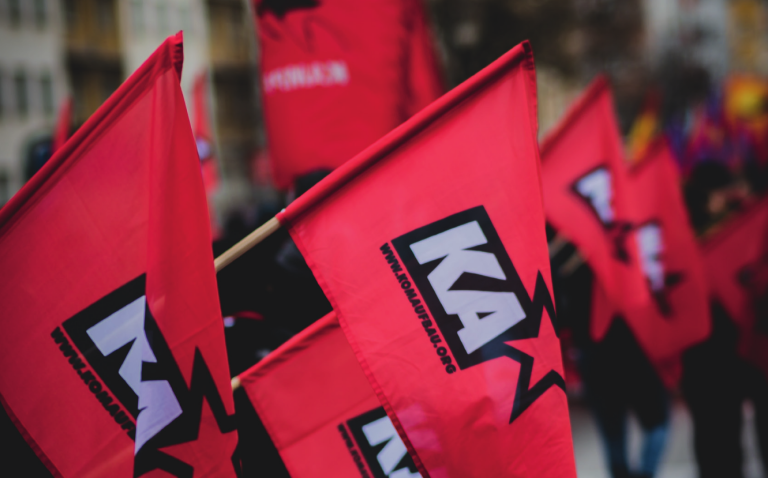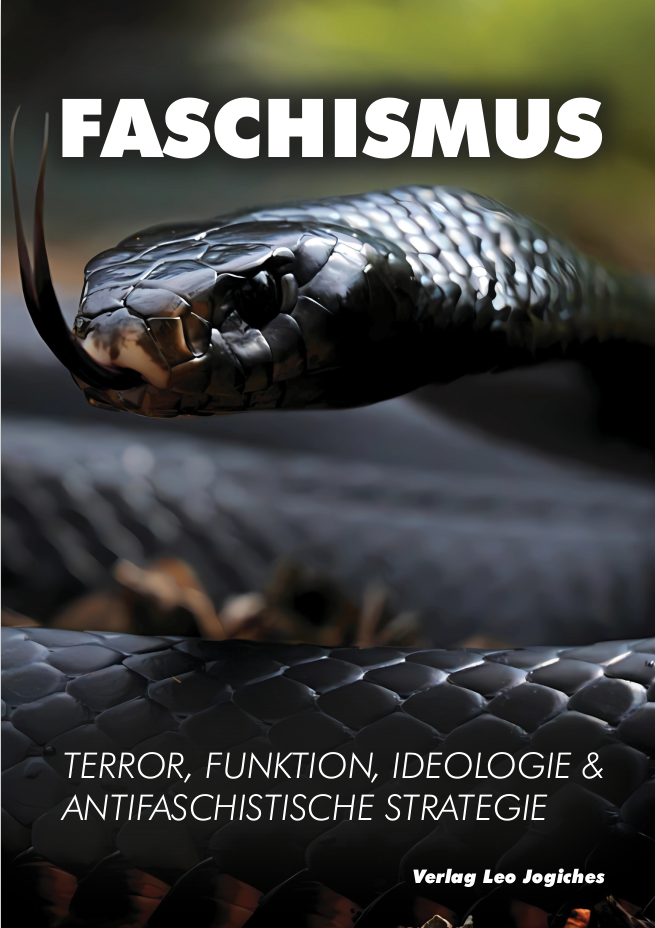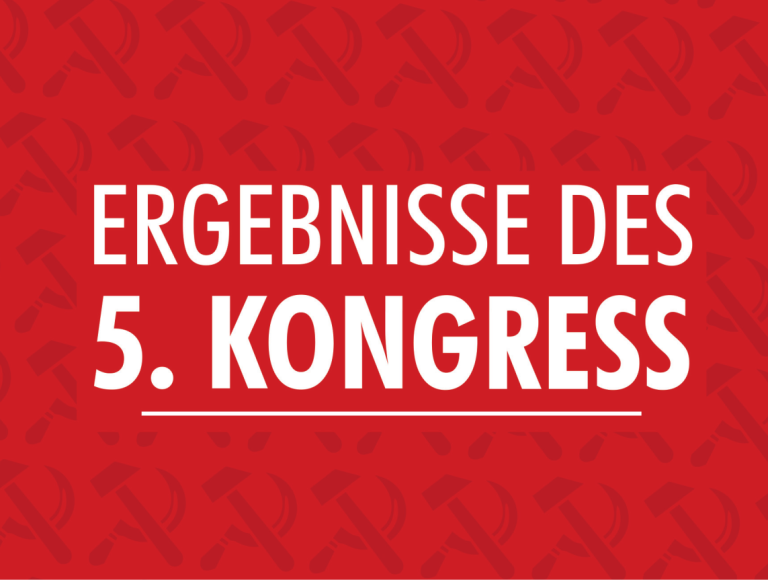The following text is one of the 4 political resolutions our 5th Congress agreed upon to share our current assesment of the political situation and our own goals for the coming period with the public.
Especially in times of sharpening contradictions in the political situation, our task as communists is to analyze them correctly, to recognize developmental tendencies and to draw conclusions from them that will guide us in our politics. In doing so, it is important to analyze the development of the imperialist world system, the effects of this on German imperialism and its state policy, as well as the development of class struggles more precisely.
The Development of the Imperialist World System
The imperialist world system is in a phase of reorganization. In the struggle for world hegemony, China and the USA have developed into the two main imperialist states, which are fighting for the leading position today. China continues to develop at a rapid pace and is able to close some of the gaps to US imperialism, for example in the area of technological supremacy, while it still lags behind in terms of military power and control over a world reserve currency. The USA has also recently been able to slow down the decline in its political and economic power – among other things by further strengthening its own global monopolies.
The distance between the USA and China to other imperialist powers remains large. And yet the imperialist world system has become more complex and there are more relevant protagonists than in the “Cold War” phase, for example. Today, we see further strong imperialist powers such as Russia, Japan, India, South Korea, France, the United Kingdom and German imperialism, each of which is trying to play a part at international level, to defend and further expand its own influence. The intensified struggle for world hegemony is leading to the following tendencies, which have already been developing for several years:
1. Preparing the Battlefield
The preparations of the imperialist powers for a direct major war to redivide the world are in full swing. In the Ukraine war, the various imperialist powers are clashing ever more directly. Regardless of whether a ceasefire or even a truce can be negotiated in phases, this is unlikely to be followed by a longer peaceful phase. The general tendency is to prepare for an even greater escalation. Both NATO officials and Russian military personnel are talking about the need to be prepared for a direct confrontation in a few years‘ time. This trend is also supported by the expansion of sabotage actions and hybrid warfare against critical infrastructure in Western Europe and the extension of the battle for control of Eastern Europe to other countries in the region, such as Georgia, Moldova and Romania. Both NATO and Russia are trying to increase their influence there and install governments that are sympathetic to them.
The fact that the trend towards a world war is becoming ever stronger is also evident in the intertwining of different theaters of war. Not only are military personnel from NATO countries fighting on the Ukrainian side, but North Korean soldiers are also fighting on the Russian side. At the same time, Russian imperialism was so strongly involved in this conflict that the Assad dictatorship was toppled in Syria and Russia was strategically weakened here, as was Iran. Meanwhile, the conflict with China continues to draw the USA away from excessive involvement in the Ukraine war and the Israeli multi-front war also requires its attention.
2. Politics of Annexation and Plunder
Russia’s move to annex part of Ukraine since 2022 is symbolic of a new phase of openly questioning borders and the policy of robbery and revanchism. China wants to take over Taiwan “peacefully”, but is also preparing a military takeover. American imperialism is now also openly declaring its intention to annex Greenland, the Panama Canal and Canada. These territorial claims, dismissed with derision in the bourgeois press, are likely to be the first signs of the future US strategy of subordinating the entire American continent even more directly and pushing back the influence of Russia and China in particular.
The rapid changes in the political-geostrategic situation in West Asia also show us how seriously we should be taking the preparations for war. On October 7, 2023, a regional alliance went on the offensive against Israel, merging the legitimate struggle against colonial oppression, the interests of the national bourgeoisie and struggles for regional supremacy. As a result, imperialist Israel, driven into a corner, not only managed to commit open genocide with impunity, but also to wage the multi-front war successfully despite losses. In the slipstream of the weakening of Hezbollah, Iran and Russia, Turkey was then able to gain relevant control over parts of Syria by meThe following text is one of the 4 political resolutions our 5th Congress agreed upon to share our current assesment of the political situation and our own goals for the coming period with the public.ans of fundamentalist forces supported by them, which was accompanied by open calls for the annexation of larger parts of Syria. The Israeli bourgeoisie is also securing part of what it sees as “Greater Israel” in Syria and is preparing the complete annexation of all remaining Palestinian territories.
We can see that the phase of world redivision has picked up speed and all powers are trying to use the remaining window of opportunity to put themselves in the best possible starting position for even greater battles. These developments are accompanied by increased large-scale refugee movements, which are also being fueled by the destruction of living space in the wake of the climate crisis.
3. Continued Economic War
A new deep crisis slump has yet to materialize. Instead, many countries have remained stuck in a permanent crisis. There are many reasons for this. One element is the continuing massive distortion of the capitalist crisis cycle through gigantic government spending. The global debt ratio continued to rise rapidly in the past period and the global debt mountain is slowly approaching its historic peak at the end of the Second World War. In the long term, however, this is leading to massive instability in the imperialist global economy and to greater pressure on national budgets, whose room for maneuver is shrinking and which are simultaneously pushing for rearmament.
The struggle for hegemony between the US and China continues to intensify in the economic sphere – currently in the form of an intensified tariff war, which at times has come close to an almost complete mutual trade embargo. The aggressive trade policy of US imperialism is aimed at a number of other countries. They are to be forced to choose a “side” – namely the American one. This not only has political repercussions, but also influences access to important raw materials and the associated international production chains.
However, it must be emphasized that despite attempts to decouple and shorten international production chains, both the US and China remain massively interdependent and economically linked. This was recently demonstrated by the temporary suspension of the tariff dispute. The same applies to all other imperialist and non-imperialist countries. Even in times of preparation for a new world war, the capitalist economy can no longer return to purely national or even regional production and marketing.
Germany is one of the imperialist countries that suffers most from economic divergence and economic warfare. Due to its extremely export-oriented economy, it is dependent on good trade relations with and between all world powers. The tariff attacks by the USA against the entire EU therefore hit Germany particularly hard. The attempts by Elon Musk, as the richest man in the world, to promote fascist movements in Europe, which leave the continent at his mercy, show how aggressively American imperialism is also taking action against its “partners” in this new phase of imperialist competition.
4. The Crisis of “Liberal Democracy” and the Rise of Fascist Powers
The increasing crisis and escalation is also reflected at a political level. Between mid-2024 and early 2025, for example, there were a series of government crises and even attempted coups in leading imperialist countries such as South Korea, France, Germany, Austria and Canada. Various reactionary forces are pushing forward here (Rassemblement National, AfD, FPÖ), which are already in power in other imperialist countries or regional powers, such as the parties of Putin, Meloni, Erdoğan, Modi or Trump.
This is a reaction by the ruling classes to the escalating of the imperialist world system and the fact that conflicts are having to be resolved less and less through compromise and more and more through violence. This makes it necessary for the respective monopoly bourgeoisies to rely more heavily on more aggressive representatives of national interests and repression both internally and externally.
They are also trying to find a replacement for the dwindling cohesion of “liberal-democratic” parties and forms of government among the broader masses. At the same time, no Western imperialist country, despite ultra-right politicians at the top, has yet made the transition to fascism, in the sense of a complete restructuring of the state apparatus, to an open dictatorship – even if the Trump administration, for example, is increasingly openly pushing its own leeway to the right. However, the possibilities for a transition to fascism in a Western imperialist country are growing and becoming a real option, especially if direct confrontations between various imperialist powers and resistance from the working class increase.
The situation of German imperialism
The aforementioned intensification of inter-imperialist contradictions is also having a massive impact on German imperialism. Our last congress had already stated in a resolution that for German imperialism, the start of the war in Ukraine „marks the end of a decades-long model of success. This consisted of developing into the dominant economic and political power in Europe in the foreign policy and military slipstream of the USA, while at the same time seeking the most advantageous economic relations possible with other imperialist predators such as Russia or China. Against this backdrop, German imperialism is now faced with the situation that it must overcome military and political deficits as quickly as possible in order to be able to successfully participate in such a war of redistribution. If this does not succeed, there is a threat of permanent relegation to the rank of an imperialist power without any independent geostrategic capacity to act.“
It is now becoming increasingly apparent that not only military and political deficits, but also economic problems resulting from international contradictions need to be overcome. German imperialism has been in a structural economic crisis since 2018/2019. This can be seen, for example, in the fact that industrial production is still well below the level of early 2018 and that Germany’s overall economic output has been in a state of fluctuating stagnation ever since. According to bourgeois forecasts, this is set to continue over the next few years. There has not been such a long economic “dry spell” since the Second World War.
The coalition government had attempted to respond to these various political, military and economic challenges, with many projects falling short of the actual needs of German imperialism. The new grand coalition under the leadership of the monopolist favorite Friedrich Merz (CDU) is trying to close existing gaps in the interests of capital:
- The „Ampel“ government1 had already fully planned out the Bundeswehr’s special funds and developed an “Operational Plan Germany” for a major war. The stationing of US medium-range missiles from 2026 was also promised. But that was not enough. Even before the transition to the new government, the SPD, Greens and CDU joined forces to decide on a gigantic rearmament package: 500 billion for infrastructure (which is immediately critical to war) and virtually unlimited borrowing in the military sector. German Foreign Minister Johann Wadephul (CDU) has already signaled his openness to spending up to 5 percent of gross domestic product – more than double the current military budget.
- With government support measures, the „Ampel“ goverment had attempted to counteract the inflation caused by the war in Ukraine and at the same time finance the German energy and industrial transition – however, energy and consumer prices remained at a very high level. These strategic problems remain fundamentally unchanged.
- Various attempts have been made to counteract the lack of self-sufficiency in key raw materials and strategic technologies via agreements and the establishment of chip factories in Germany. As of yet, with limited success. This applies in particular to the areas of artificial intelligence, the internet and geodata services, as well as space. Here, too, the new Merz government will take a more aggressive approach.
- In terms of trade policy, the Mercosur agreement with South America has been successfully brought onto the final leg and German imperialism is also securing access to rare earths within Europe, for example with the lithium project in Serbia. However, a sufficient response to tariff wars with the USA or a drop in imports from China is not in sight. It remains to be seen to what extent the EU will be able to maintain its outward unity against American attacks.
- Various German companies are still among the world leaders in the development of productive forces. However, German monopolies are lagging far behind the competition from the USA and China, particularly in the areas of artificial intelligence, electromobility and space exploration. Under the heading of “cutting red tape”, a reduction in workers‘ rights, consumer protection rights and environmental standards is to be expected.
The fallout from the economic crisis and its own political measures have been passed on to the working class by the Ampel government. The current SPD-CDU government is now continuing this policy even more aggressively. Although the rate of inflation has fallen steadily over the last two years, it still remains at a high level, resulting in a further creeping reduction in living standards. In the past, working-class households were particularly affected by high food and energy prices, while lower middle-class households were also exposed to greater burdens as a result of the “Heating Act”, for example. Meanwhile, subsequent wage increases have not been able to compensate for an inflation rate of 19% since the beginning of 2021, but have merely cushioned it somewhat. Here, the DGB in particular is a key factor in cementing the real wage cuts in the central wage agreements.
The German monopolies are also trying to improve their position at the expense of the workers: The frequently announced job cuts already include hundreds of thousands of jobs in industry and an increased number of bankruptcies and factory closures mean that workers in all other sectors of the economy are also being put out on the street. At the same time, social plan methods are being used to prolong these processes and in some cases new jobs are being found straight away, as there is still a severe shortage of skilled workers. However, the annual average unemployment rate is already at its highest level since 2016 and is likely to rise further.
The crisis situation and the policies of the traffic light coalition, which presented itself as progressive but in reality implemented particularly reactionary policies, allowed right-wing forces to continue their rise. This was also evident in the last federal election, in which the AfD became the second strongest force after the CDU. The non-cooperation of other bourgeois parties with the AfD is crumbling at local and regional level. Broad media and political campaigns against the citizens‘ income (Bürgergeld) and refugees serve both right-wing parties. However, it is not yet a government option at national level, leaving only a grand coalition.
The extent to which the CDU will actually succeed in “winning back” voters from the AfD in the current government remains to be seen. In any case, the SPD has already signaled that it will support a series of tightening measures. Either way, there will be a further shift to the right, partly because German imperialism has to manage to take a big step forward. The war credits have created an important financial framework for this. The planned abolition of the 8-hour working day and attacks on the citizens‘ income already indicate that the borrowing is to be flanked by increased exploitation. Although it does not currently look as if a new world war is about to start in the next 1-2 years, the preparations are likely to continue with all the accompanying consequences. In addition to rearmament, this also includes the reintroduction of compulsory military service based on the Swedish model.
The Development of Class Struggle and Spontaneous Movements
The intensification of the inter-imperialist contradictions described above, the preparations for a new world war and the ongoing economic crisis, as well as its massive problems in converting key industries to new technologies, have also created the need for German imperialism to wage more severe class struggles from above. This is particularly evident in the attacks on workers‘ rights, the right to asylum, chauvinist agitation against the unemployed and recipients of citizens‘ benefits, as well as the armament and expansion of the powers of the police, military and secret services.
Parallel to the continuing inflation, the wage demands in the collective bargaining negotiations of recent years were also comparatively high. However, if one is not deceived by the simple figures, it is noticeable that even the maximum demands of the yellow unions took into account massive real wage losses. The “wage increases” then negotiated were usually a direct slap in the face for our class. Agreements that barely amounted to half the wage increases of the trade union demands and were usually at least twice as long in duration manifest the loss of real wages not only for the past, but also for the coming years.
Even though the number of strikes and labor disputes has increased in the last two years, they still lag behind many other countries in an international comparison. There can be no talk of active struggles or a real upturn in working class activity. In 2023, the number of people taking part in strikes fell from 930,000 to 857,000, even though the number of days lost rose sharply. This means that not even 1.9% of the working population took part in strikes. However, the spontaneous work stoppages in numerous industrial companies, which occurred repeatedly last year in connection with the announcement of mass redundancies and plant closures, should be highlighted here. In the vast majority of cases, however, these independent struggles by the workforce were contained and pacified by works councils and trade unions as quickly as they broke out.
The intensification of the threat of war, economic crises and right-wing developments have contributed to a greater differentiation in social democracy and, with it, in the political resistance movement and the various spontaneous movements. The majority of social democracy has followed the general trend and moved strongly to the right, adopting an openly pro-imperialist stance on the vast majority of issues. This was followed by the DGB trade unions and ever larger sections of the political resistance movement, which plunged them into a general crisis or exacerbated it. The existing major mass protests of recent times, such as the climate movement or the anti-AfD protests, were almost completely under bourgeois hegemony and have hardly led to a weakening of the right-wing movement or to a lasting strengthening of class-struggle forces. On the contrary, repressions against anti-fascists have continued to increase in parallel and have led to more and higher prison sentences in recent years. The anti-AfD movement has also hardly been able to influence the AfD’s polls and election results. In the short term, it was the Left Party that was able to capitalize on anti-AfD sentiment in the early federal elections in 2025 and significantly increase its membership and voter base. However, as expected, they quickly exposed themselves as a verbally radical “opposition” who limit themselves primarily to formulating moral appeals and fighting for half-baked compromises within their own ranks.
The generally described development of class struggles is also reflected in the women’s movement. Here, too, the development of struggles in Germany is lagging behind international standards in terms of quantity and quality. While the increasingly reactionary policies in many countries, such as the USA, Turkey, Italy and Poland, have led to the mobilization of large numbers of women onto the streets in isolated cases or for longer periods of time, and women taking the lead in the protests, hardly any significant momentum has developed in Germany so far, despite the massive increase in domestic violence and femicides. The influence of bourgeois feminism is predominant and there is hardly any counter-tendency worth mentioning. At the same time, recent years have also shown us increasing success in mobilizing for demonstrations oriented towards class struggle, be it on the Day against Violence against Women or on 8 March. However, these are short-term successes that do not yet allow any analysis of quantitative or qualitative development.
A central movement in recent years, especially since October 7, 2023, has been the movement in solidarity with Palestine. Here, too, we have seen particularly clearly the increase in repression described above and the division within the political resistance movement and, to a very large extent, its further rightward development. A gigantic campaign was launched in an attempt to suppress any expression of solidarity with the Palestinian people and make it a punishable offense. Similar to the war in Ukraine, the ruling class has used the war in Palestine to test and permanently enforce massive attacks on freedom of expression, freedom of demonstration and other democratic rights. Further armament and the suppression of anti-war protests also have the potential to generate greater contradictions to the ruling policy in Germany in the future. In particular, the introduction of compulsory military service based on the Swedish model and discussions about the reintroduction of full compulsory military service offer great potential for mobilization, especially among young people, who would be the first to be affected by any form of compulsory military service.
The escalating political situation in relation to the crisis of the political resistance movement is leading to sorting processes and a reorganization of forces within the revolutionary and communist movement. This has strengthened the upswing of the communist movement, but so far it has not been able to compensate for the downward trend of the political resistance movement as a whole.
Thus, we see that political developments at both national and international level are changing and intensifying at a speed that is currently confronted by a workers‘ movement that is too weak and lacking communist leadership. At the same time, the escalating crises and the increasing attacks on our class have the potential to develop faster and to be exploited by a more organized and consistent intervention of revolutionaries. It is our task to do everything we can to change the state of the communist and workers‘ movement and match the pace of the ruling class: We must increase our efforts and dare to take faster, bigger steps to put ourselves in the best possible starting position for the sharpening class struggle!
1The “Ampel” Government was the ruling coalition under Chancellor Olaf Scholz, consisting of the SPD (Red), the FDP (Yellow) and the Greens. “Ampel” means traffic light in German.



